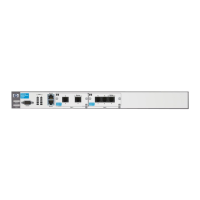14-7
Using the Web Browser Interface for Basic Configuration Tasks
Managing Files, Firmware, Boot Software, and the AutoSynch™ Function
Managing Files, Firmware, Boot
Software, and the AutoSynch™
Function
In the Utilities section of the Web browser interface, you can do basic file
management tasks, manage the AutoSynch function, and set the router’s
firmware and boot software using the Web browser interface.
The Utilities section of the Web browser interface includes the following
subsections:
■ AutoSynch
■ Configuration
■ Firmware
■ Logging
■ Debug
■ Reboot Unit
■ Telnet to Unit
The AutoSynch section allows you to enable the AutoSynch technology and
force synchronization. For more information about AutoSynch functions,
see Chapter 1: Overview.
The Configuration section allows you to create and manage configuration
files.
In the Firmware section, you can configure the router’s primary and backup
firmware files, view the drive space that is used and free on the router’s
internal flash and compact flash memories, upload, and delete firmware files.
The Logging section lets you configure the event-history log of events logged
by the Secure Router OS firewall.
The Debug section lets you activate debug messages that provide real-time
troubleshooting information about the activity of certain interfaces, proto-
cols, and operations on the router.
The Reboot Unit section provides two options for rebooting the router: save
and reboot or reboot without saving.
The Telnet to Unit section opens a terminal session on your PC and begins to
negotiate a Telnet session between your PC and the router.

